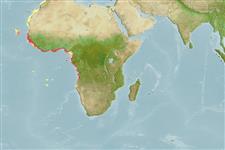Teleostei (teleosts) >
Eupercaria/misc (Various families in series Eupercaria) >
Sciaenidae (Drums or croakers)
Etymology: Pseudotolithus: Greek, pseudes = false + greek, otos = ear + Greek, lithos = stone (Ref. 45335).
More on author: Bleeker.
Environment: milieu / climate zone / depth range / distribution range
Ecology
Marine; demersal; depth range 0 - 150 m (Ref. 2683), usually ? - 60 m (Ref. 3593). Tropical; 35°N - 17°S, 25°W - 14°E
Eastern Atlantic: Mauritania (Ref. 5377) to Angola, becoming scarce north of Cape Verde. Often confused with Pseudotolithus senegalensis.
Length at first maturity / Size / Weight / Age
Maturity: Lm 48.3 range ? - ? cm
Max length : 140 cm TL male/unsexed; (Ref. 40637); common length : 50.0 cm SL male/unsexed; (Ref. 4780); max. published weight: 15.0 kg (Ref. 40637)
Short description
Identification keys | Morphology | Morphometrics
Dorsal spines (total): 10; Dorsal soft rays (total): 28 - 32. Diagnosis: dorsal fin with 9 spines in the 1st part and 1 spine and 28-32 in the second; second anal spine about half the length of the 1st anal fin soft ray; pectoral fins short, about 19-21% SL; gill rakers short, about as long as gill filament at angle between lower and upper part of gill arch; maxilla extending beyond posterior eye border, eyes small, 7.2-8.4 times in HL, but this character is difficult to use for identification because of allometry (Ref. 81656).
Inhabits coastal waters from shoreline to about 150 m depth, over mud and sandy mud bottoms. Most abundant in waters less than 60 m at temperatures above 18°C. Juveniles and sub-adults enter estuaries and rivers. Feeds mainly on small fishes and crustaceans. Peak spawning season from late spring to early autumn in tropical West Africa (Ref. 4780).
Life cycle and mating behavior
Maturities | Reproduction | Spawnings | Egg(s) | Fecundities | Larvae
Chao, L.N. and E. Trewavas, 1990. Sciaenidae. p. 813-826. In J.C. Quero, J.C. Hureau, C. Karrer, A. Post and L. Saldanha (eds.) Check-list of the fishes the eastern tropical Atlantic (CLOFETA). JNICT, Lisbon; SEI, Paris; and UNESCO, Paris. Vol. 2. (Ref. 3593)
IUCN Red List Status (Ref. 130435)
Threat to humans
Harmless
Human uses
Fisheries: commercial
Tools
Special reports
Download XML
Internet sources
Estimates based on models
Preferred temperature (Ref.
123201): 19.2 - 27.9, mean 25.7 °C (based on 104 cells).
Phylogenetic diversity index (Ref.
82804): PD
50 = 0.5156 [Uniqueness, from 0.5 = low to 2.0 = high].
Bayesian length-weight: a=0.00661 (0.00363 - 0.01204), b=3.06 (2.91 - 3.21), in cm total length, based on LWR estimates for this species & (Sub)family-body (Ref.
93245).
Trophic level (Ref.
69278): 3.7 ±0.5 se; based on diet studies.
Resilience (Ref.
120179): Medium, minimum population doubling time 1.4 - 4.4 years (K=0.22-0.29; tmax=7).
Fishing Vulnerability (Ref.
59153): Moderate to high vulnerability (49 of 100).
Nutrients (Ref.
124155): Calcium = 62.8 [36.3, 118.9] mg/100g; Iron = 0.842 [0.417, 1.457] mg/100g; Protein = 19.1 [17.9, 20.3] %; Omega3 = 0.198 [0.109, 0.333] g/100g; Selenium = 88.4 [48.5, 173.3] μg/100g; VitaminA = 10.3 [3.8, 29.3] μg/100g; Zinc = 0.763 [0.547, 1.103] mg/100g (wet weight);
